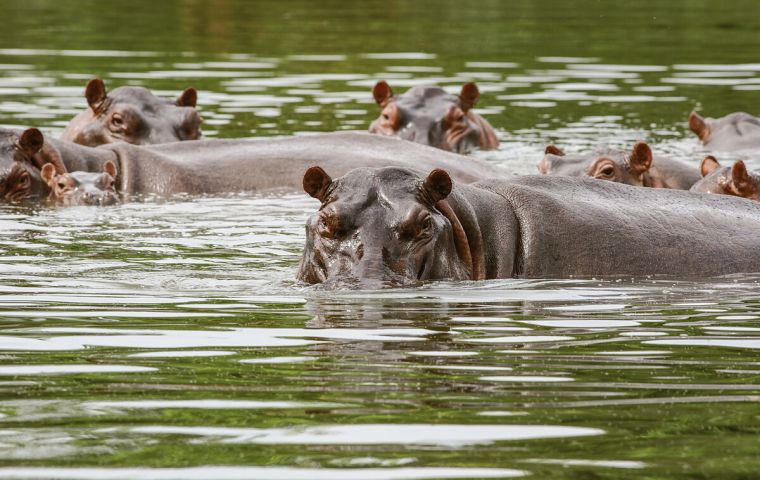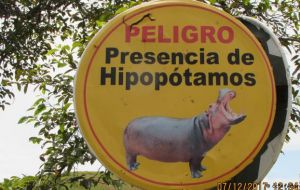MercoPress. South Atlantic News Agency
Drug lord Pablo Escobar legacy to Colombia, the invasive ecosystem engineers, African hippos
 The infamous Pablo Escobar, smuggled four hippos from a wildlife park in Dallas, Texas, into his new exotic zoo east of Medellín, his city.
The infamous Pablo Escobar, smuggled four hippos from a wildlife park in Dallas, Texas, into his new exotic zoo east of Medellín, his city.  They became part of his 2,000-hectare Hacienda Napoles ranch in Puerto Triunfo, which comprised a Spanish colonial house, a landing strip, many artificial lakes
They became part of his 2,000-hectare Hacienda Napoles ranch in Puerto Triunfo, which comprised a Spanish colonial house, a landing strip, many artificial lakes The legacy of Colombian drugs lord Pablo Escobar has not only been the ongoing gangs war and the overall violence in the country, but also consequences of some of his hobbies, for example growing exotic fauna, such as hippos.
In effect Colombia boasts the biggest hippo population outside of Africa. Different estimates point to something between 90 and 180 animals, but there are still doubts about the real number.
“What worries me more about this is that the population has continued to grow exponentially,” German Jimenez, a biology professor at the Pontifical Javierian University in the Colombian capital, Bogota
The infamous Pablo Escobar, who terrorized Colombia during the 1980s and early 1990s, resulted in thousands of deaths. And in the 1980s, he smuggled four hippos from a wildlife park in Dallas, Texas, into his new exotic zoo east of Medellín, his city.
They became part of his massive 2,000-hectare Hacienda Napoles ranch in Puerto Triunfo, which comprised a Spanish colonial house, a landing strip, many artificial lakes, roads and even its own gas station.
Escobar wanted a truly exotic wildlife park, so he also brought rhinos, elephants, giraffes, ostriches and many more animals, calling it his “own Noah’s Ark.”
In 1993, Colombian security forces finally shot and killed Escobar in Medellin. After his death, many of the exotic animals went to other zoos or parks, but the hippos stayed at the hacienda — and eventually escaped, to a place where they probably felt quite at home.
The Hacienda Napoles, which is now a state-owned theme park, is very close to the Magdalena River, one of the country's major arteries, and the river basin shares similarities with the hippos' native ecosystem in various African countries.
With the ideal place to breed and a lack of government action, and natural predators, the hippo population grew fast. “Colombia had the opportunity to [control their population] but failed and let the problem grow,” said Jimenez.
The hippos In Colombia have no competitors and no predators. They enjoy steadier weather and water levels than in Africa, where intense droughts act as population control.
Basically, the animals can eat and mate all year round in Colombia. Meanwhile in Africa, the number of hippos has dropped sharply since the 1970s. In 2016, the International Union for Conservation of Nature listed them as “vulnerable,” the last classification before “endangered.”
“They can start reproducing really young. They can have calves very frequently, like once or more a year. And they can reproduce for a very long time, 50 years, almost to the end of their lifespan,” Amanda Subalusky, a biology professor at the University of Florida said.
Subalusky and Jimenez worked together on a study published last month in the journal Scientific Reports, in which they stressed the urgency of the issue and examined potential solutions, as well as their costs.
“They're reproducing and growing very fast,” said Subalusky. The problem with invasive species is that they can seriously affect wildlife, the local ecosystem, the landscape and also the people of their new home.
Hippos are very territorial and can be very aggressive. In fact, they are well-known in Africa for being one of the deadliest animals, with estimates saying they kill around 500 people every year.
Although no one has been reported killed by hippos in Colombia to date, there have been incidents of attacks and crashes with vehicles. The low population density, according to scientists, is the likely reason for the low number of attacks.
Hippos are a concern for farmers as well because they can destroy fences, consume crops and grass, and sometimes even run over calves. Besides hippos eat around 50 kilograms of plants a day. That’s a heavy toll on the local vegetation. “They are strongly affecting the ecosystems of the Middle Magdalena,” said Jimenez. The animals' heavy weight can change the landscape as they walk around.
And because hippos are so big and eat so much, well, they also poop a lot. Since so much dung ends up in rivers, the extra nutrients it releases into the water can lead to algae blooms. This can deplete the water's oxygen content, which is essential for fish survival.
Hippos are what scientists refer to as ecosystem engineers because of how drastically they can alter the landscape. Like beavers in the forests of North America, these engineers play a vital role in many ecosystems. But they can wreak havoc in a foreign environment.
The fact that not everyone agrees with that became clear in 2009, when the government ordered the death of a hippo called Pepe that was posing a threat to locals. Pepe's death sparked a public outcry, and in 2012 a law was passed making it illegal to kill hippos.
Only subsistence hunting, or hunting for food in communities that rely on it, is permitted in Colombia, explained Jimenez. But in 2022, the Colombian government passed a new law declaring hippos an invasive species. The law is now being contested by animal rights groups because it contradicts previous legislation protecting hippos.
Subalusky and Jimenez's study said all hippos need to go, stating that with the current legal situation, the most cost-effective option would be to continue male sterilization. They estimated the costs between US$ 0.85 and US$ 1.4 million, but eradication would take at least 45 years.
However, the researchers showed that using veterinary-assisted euthanasia would be the most effective and fastest solution. They estimate that the whole hippo population could be euthanized in a single year for around US$ 610,000.
After this report, the Environment and Sustainable Development Ministry published a press release on April 14 that said it was “working on the management plan to be adopted for this species in the country.”
Scientists agree that the growth rate of hippos is worrying, and that the longer the Colombian government waits, the harder it's going to be to control the animals. Any delay could have serious consequences for the Magdalena River basin and for the people living there.




Top Comments
Disclaimer & comment rulesCommenting for this story is now closed.
If you have a Facebook account, become a fan and comment on our Facebook Page!